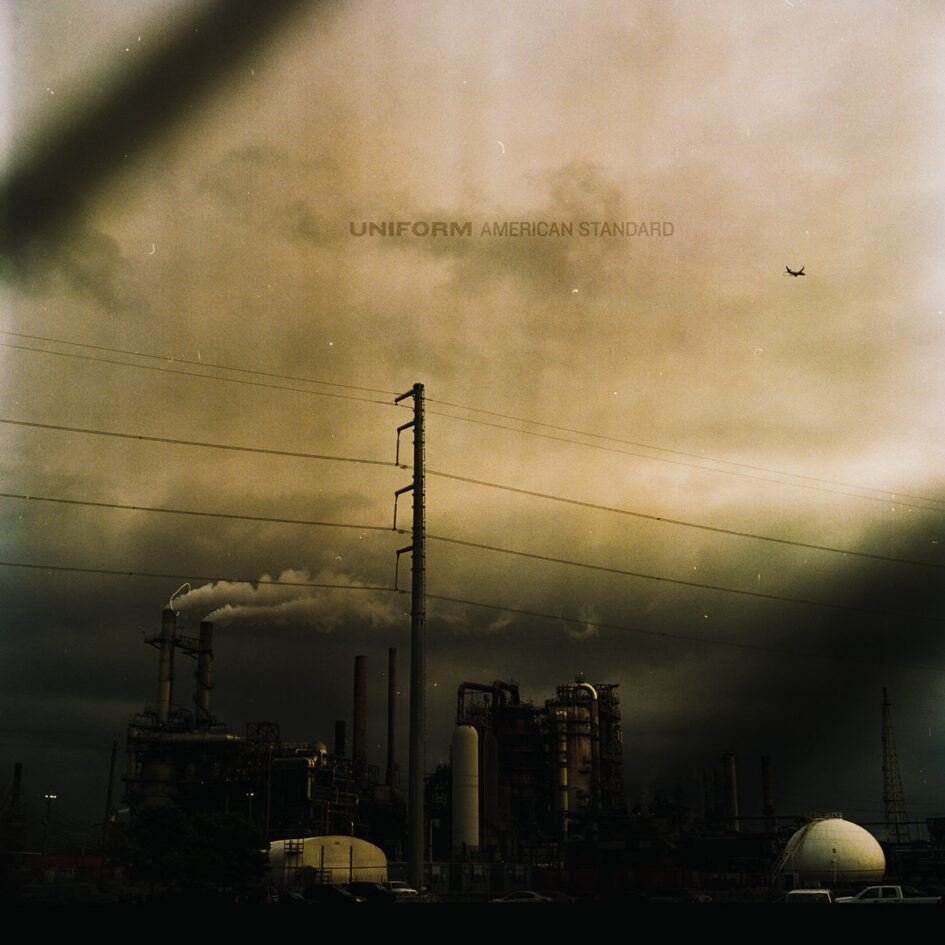 A desolate scene decorates the cover of Uniform’s new album American Standard. In it, a power plant or some kind of processing site is blasting smoke into the air, and the yellow hue of the semi-dark scene suggests heavy pollution. The cars of workers are parked in front of the complex; there are fences and power lines leading to or from the site. Except for the clouds, there is nothing in the picture that is natural, nothing that isn’t man-made. It’s not a liminal space. It’s a space beyond a border that we appear to have crossed a long-time ago. There is no greenery to be seen anywhere, no animals, nothing beautiful, nothing that would generate positive feelings. It’s a space that our pre-industrial ancestors would probably perceive as frightening, as alien, as non-human, as not of this world.
A desolate scene decorates the cover of Uniform’s new album American Standard. In it, a power plant or some kind of processing site is blasting smoke into the air, and the yellow hue of the semi-dark scene suggests heavy pollution. The cars of workers are parked in front of the complex; there are fences and power lines leading to or from the site. Except for the clouds, there is nothing in the picture that is natural, nothing that isn’t man-made. It’s not a liminal space. It’s a space beyond a border that we appear to have crossed a long-time ago. There is no greenery to be seen anywhere, no animals, nothing beautiful, nothing that would generate positive feelings. It’s a space that our pre-industrial ancestors would probably perceive as frightening, as alien, as non-human, as not of this world.
In combination with the album title, the cover photograph might trick you into assuming that the album is about the state of the American nation or the state of Western civilization in general. It might make you believe that pollution, the dominance of ugly, man-made structures, and the alienating nature of life in such surroundings are the themes of the band’s new LP. But that is not the case, or at least not primarily.
American Standard, you see, is the name of an American toilet manufacturer. Yes, you read that right. The sonic hurricane of abrasive music, raw lyrics and corrosive vocals that is Uniform’s new album does not portray the decay of the West, but singer Michael Berdan’s decades-long and ongoing struggle with bulimia nervosa. “The following songs are about a lifetime of making myself vomit,” Berdan writes in an essay that accompanies the album.
In this biography, sent along with the release, Uniform encourages the listener to look beyond the music and the lyrics, to dig, to try to get to what lies underneath. So, I did. A quick search on the internet will inform you about the fact that eating disorders are on the rise, that they are a silent epidemic, afflicting all genders, all social classes, all races. But primarily in Western civilizations. In a time span of just under two decades, the numbers of people afflicted by these disorders have doubled. Obviously, I’m not qualified to judge these numbers, but I can tell you this from my own experience: American Standard is the third album in extreme music in under a year that I’m reviewing that has eating disorders as a subject. In the years before that I hadn’t come across any such album which, of course, doesn’t mean that there weren’t any.
One of the first questions to ask might be what causes eating disorders or what contributes to their rise. From what I gather, it’s difficult to pinpoint. Diet culture might be to blame, the highly processed food we eat, but also unrealistic body images and social media which helps spread them. There is no one trigger. What is certain though is that childhood trauma plays a decisive role, like it does with the majority of all mental health issues and substance addictions. Childhood trauma is also something that comes up in the lyrics of American Standard.
Another generator of self-harm and one that I have observed myself in our shared sub-culture of extreme music, especially in (young) men, is self-loathing. I find that it is particularly prevalent in music genres that formerly thrived on aggression turned outward, turned against the system, and that stressed the need of behaving decently towards your fellow beings, like for example hardcore.
Without being able to pinpoint one reason as the cause of eating disorders, we must assume that the entirety of the way we are living today, our transformed social structures, our alien and nature-absent surroundings, the kind of food we eat, the way we spend our time, contribute to the rise of these illnesses. Which brings us back to the depressing scene on the album’s cover. Do you think that one can raise healthy children in this environment?
The almost forty minutes of American Standard are obviously not an easy listen. Of the four songs, the first one, the title track, makes up half of the whole album, lasting 21 minutes. However, this should not discourage you. The album is of jaw-dropping intensity, and considering the subject matter as well as the grinding, pulverizing character of the band’s music and the near-constant shouting, the fact that it is, in all its chaos and its fury, actually fascinating to encounter makes it a feat of music writing and an appealing work of art. Influences are multiple and varied, from Einstürzende Neubauten to Helmet to Swans and Celtic Frost. And while Uniform are not a hardcore band, I would argue that you can tell exactly where they are from, because they carry a good portion of the violent aura of New York City’s early hardcore acts. The possibility of violence, the very real chance of things boiling over any second, makes the band’s industrial noise sound not only edgy but also dangerous, an absolute rarity among today’s acts.
Are you afraid of what the future holds for us? Of course you are. And you’re not alone.
(8.5/10 Slavica)

Leave a Reply